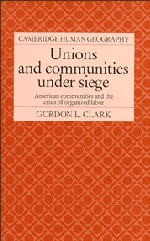Book contents
- Frontmatter
- Contents
- List of tables
- Preface
- Acknowledgments
- PART I ECONOMY AND COMMUNITY
- PART II DRAMA OF ECONOMIC RESTRUCTURING
- 3 Communities and corporate location strategies
- 4 Rationing jobs within the union, between communities
- PART III UNION PERFORMANCE IN REPRESENTATION ELECTIONS
- PART IV REGULATING LOCAL LABOR–MANAGEMENT RELATIONS
- PART V PROSPECTS FOR ORGANIZED LABOR
- Appendix 1 Variables and data sources
- Appendix 2 Cases cited
- Notes
- Bibliography
- Name index
- Subject index
3 - Communities and corporate location strategies
Published online by Cambridge University Press: 13 October 2009
- Frontmatter
- Contents
- List of tables
- Preface
- Acknowledgments
- PART I ECONOMY AND COMMUNITY
- PART II DRAMA OF ECONOMIC RESTRUCTURING
- 3 Communities and corporate location strategies
- 4 Rationing jobs within the union, between communities
- PART III UNION PERFORMANCE IN REPRESENTATION ELECTIONS
- PART IV REGULATING LOCAL LABOR–MANAGEMENT RELATIONS
- PART V PROSPECTS FOR ORGANIZED LABOR
- Appendix 1 Variables and data sources
- Appendix 2 Cases cited
- Notes
- Bibliography
- Name index
- Subject index
Summary
The 1980s brought considerable hardship to many people and their communities. Podgursky's (1987) study of post-1980 worker displacement for the National Academy of Sciences' panel on technology and employment (see Cyert and Mowery 1987) indicated that of the many millions of industrial workers who lost jobs in recent years few were lucky enough to find similar jobs. Displaced workers have suffered under-employment and unemployment with incomes (wages and benefits) much below previous levels. Employment in other expanding sectors (predominately service sectors), relocation, and higher levels of household labor market participation (typical blue-collar adjustment strategies) have rarely made up the difference. Indeed, some commentators argue that economic restructuring has substantially reduced the number of well-paid manual jobs and has further polarized the distribution of wages and salaries (Bluestone and Harrison 1987; Harrison and Bluestone 1987).
If economic restructuring were randomly distributed across the United States, it is doubtful its effects would have much political significance. However, economic restructuring is inherently geographically differentiated, most recently concentrated in American factory towns and cities whose histories are intimately linked to the evolution of whole industries, firms, and plants. In these communities, plant closings and worker displacement are economic and political disasters. Plant closings often mean economic desolation, massive unemployment, and the collapse of other related businesses.
Economic restructuring can also be an intense political drama, involving state and local governments, community organizations, corporations, and unions.
- Type
- Chapter
- Information
- Unions and Communities under SiegeAmerican Communities and the Crisis of Organized Labor, pp. 45 - 66Publisher: Cambridge University PressPrint publication year: 1989



